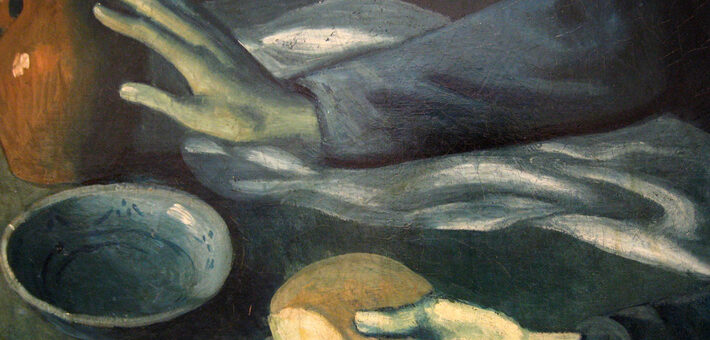Commentary on John 9:1-41
As someone who teaches exegesis, I will be the first to rate this text as “tough-to-very tough” on the “how hard is this to preach?” scale. Here’s why:
First off, it is a narrative text of over forty verses. I would respond to the eager exegesis student with a quick, “choose a smaller section!” Second, it touches on at least one scholarly debate about translation and punctuation in verse three that could easily soak up precious sermon-crafting time if one isn’t careful (but it does matter for interpretation this time!). Third, it raises at least two important theological and ethical issues:
- questions about the relationships between sin, disability, and healing
- use of the phrase “the Jews” and presentation of this group as villains1
The good news is, this is an amazing text with countless fruitful connecting points for you and your congregants. Rather than hoping for comprehensive coverage of this story, choose a short section and focus there. Note a few details or themes that strike you, grab a good commentary or two (in addition to Working Preacher, of course) and dig in. I notice a rich intersection with the translation/punctuation debate in verse three and theology of disability. But first, some context!
Some context
“And as he walked along …” The calm start to this story is a bit misleading. Jesus has just narrowly escaped being stoned to death! It’s true, John is loaded with drama from the start. The prologue predicted that Jesus’ presence on earth would produce conflict (John 1:10-11). Most often the dramatic conflict appears in response to an incredible act performed by Jesus. While the other Gospels describe Jesus’ super human actions as miracles (dúnamai, literally “mighty deeds” in Greek), John calls them “signs” (sēmeía) because they point to something important about who Jesus is—that he is God on earth—and something important about Jesus’s mission—that he came to make God known to a world that otherwise could not know God (John 1:18).
Throughout the story, these signs elicit responses to who Jesus is. Many believe at first, but as the story goes on, the opposition builds. In chapter 5, we see questions turn to persecution when Jesus heals a man on the Sabbath. When Jesus claims to be equal with God, the religious leaders plot to arrest and kill him. In last week’s text (John 7:37-52), Jesus’ claim to be the source of living water brought further division, with the belief of one group growing, and the opposition from the other group keeping pace. Just before today’s text Jesus further incites anger after he closes a heated debate with the loaded statement, “Before Abraham was, I am.” Our story falls between this provocative claim and the even more explicit Good Shepherd discourse (but more on that next week).
So that …
Even though not everyone in the ancient world agreed that disabilities were the result of sin or divine curses, we can see in the disciples’ question here a blunt assumption that someone must be to blame for the man’s condition. The answer is clear: his blindness was not because of his sin or his parents’ sin. Here this story can be a helpful corrective to what some may believe about disabilities today—that a disability is a punishment for sin.
However, biblical healing stories can sometimes reinforce another problematic theology of disability—where persons with disabilities serve as opportunities for the power of God to be demonstrated through healing. Not only does this objectify the person, it assumes that “healing” is always wanted and needed (which is not the case for all persons with disabilities), and it disregards the fact that “healing” in the form of “curing” simply will not happen for many people with disabilities.2
This is complex because the text “says” that “he was born blind so that God’s works might be revealed in him.” Well, let’s return to John 9:3-4a, with two things in mind:
- Our ancient Greek texts didn’t have punctuation or verse numbers; scribes and editors added those later to clarify interpretation and help make publishing and reading more efficient.
- Sometimes translation into another language requires addition of words or phrases to clarify meaning. Not all English translations are exactly alike, but they are far more alike than they are different. Where they differ, sometimes something interesting is going on in the original language, and it can be a good sign to pay attention!
Below I’ve included three translations—the NRSV, the NASB, and a translation from my favorite John commentary for preaching by Jo-Ann Brant3. I have bolded words that are translator additions, meaning there isn’t a simple one-to-one correspondence with a Greek word, but the words are there to smooth out the English.
NRSV
Neither this man nor his parents sinned; he was born blind so that God’s works might be revealed in him. We must work the works of him who sent me while it is day; night is coming when no one can work.
NASB
It was neither that this man sinned, nor his parents; but it was so that the works of God might be displayed in him. We must carry out the works of Him who sent Me as long as it is day; night is coming, when no one can work.
Brant
Neither did this one nor his parents sin. But in order that the works of God might be manifest to you, it is necessary for us to work the works of the one who has sent me while it is day; night is coming, when no one is able to work.
As we can tell by comparing the NRSV and the NASB, the phrase he was born blind isn’t in the original Greek. Rather, many translators add this phrase as a way to try to fill in gaps in the Greek (the NASB adds the more ambiguous, “it was,” but the idea is the same).
Brant takes it further, noticing that if we don’t add any phrases to fill in the gaps, we are left with a different interpretive option. The tiny Greek word hina, which we translate “so that” or “in order that” needs to connect two ideas. One thing happens “so that” another thing will happen. The way the NRSV and the NASB read, the man is born blind so that God’s work might be revealed. Brant’s translation connects our work to God’s work being manifest in the world— it is necessary for us to work so that the works of God might be manifest.
SO WHAT?
When viewed in context of the full Johannine story, this is a part of a pattern, where Jesus’ followers are often called to imitate him in fulfillment of his mission. We can imagine John’s readers (both back then and us today) doing the same. If Jesus’ work was to make God known, how do we carry on that work?
God’s works are revealed in the man born blind, but I see it a bit differently than I might have at first glance. Rather than a simple healing narrative, this man gets a surprising amount of stage time where he confesses belief in Jesus. He ultimately stands in stark contrast to the religious leaders who ironically do have sin and cannot see spiritually, even though they are not physically blind. The story helps us to remember our own assumptions about the relationships between sin, disability, and healing. It reminds us that many of these assumptions have affected even the processes of translation, and every time we read we can approach the text with care and creativity, humility and hope.
Notes
- For helpful information on this important topic, please see https://www.biblia.work/sermons/john-831-36-commentary-by-jaime-clark-soles/
- Kathy Black, A Healing Homiletic: Preaching and Disability (Nashville, TN: Abingdon Press, 1996), 29-30. This book is a wonderful introduction to thinking about preaching and disability.
- Jo-Ann Brant, John (Grand Rapids, MI: Baker Publishing, 2011), 153. This commentary is a must-have for any preacher’s bookshelf!
PRAYER OF THE DAY
God of miracles,
Sometimes we are slow to believe in your power, even when your miracles occur all around us each and every day. Open our eyes to see and our hearts to believe. Amen.
HYMNS
I’ve just come from the fountain (trad.)
On my heart imprint your image ELW 811
Go, my children, with my blessing ELW 543
CHORAL
There is a balm, trad.


February 27, 2022